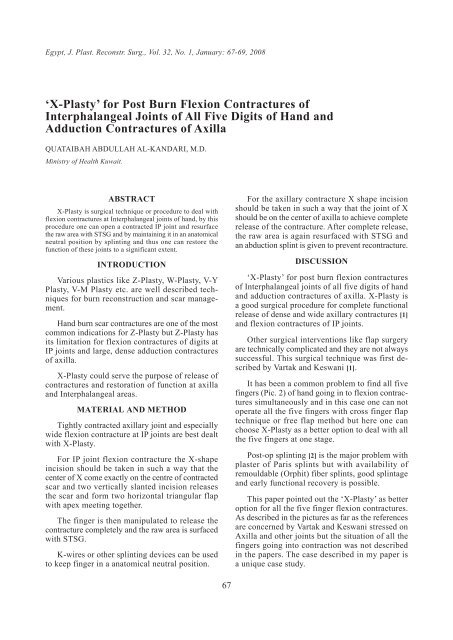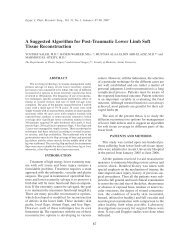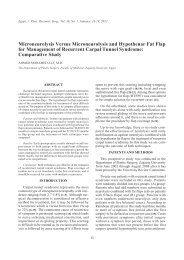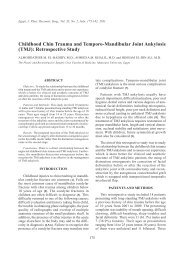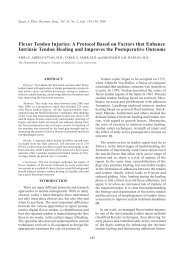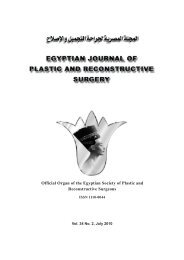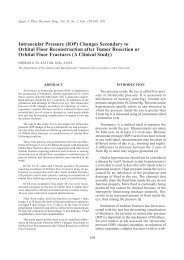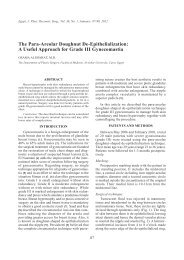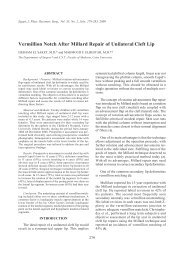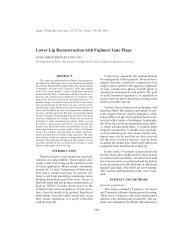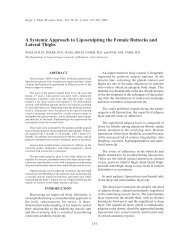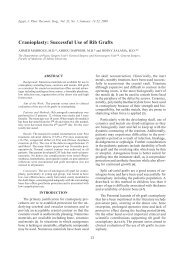'X-Plasty' for Post Burn Flexion Contractures of ... - ESPRS
'X-Plasty' for Post Burn Flexion Contractures of ... - ESPRS
'X-Plasty' for Post Burn Flexion Contractures of ... - ESPRS
Create successful ePaper yourself
Turn your PDF publications into a flip-book with our unique Google optimized e-Paper software.
Egypt, J. Plast. Reconstr. Surg., Vol. 32, No. 1, January: 67-69, 2008<br />
‘X-Plasty’ <strong>for</strong> <strong>Post</strong> <strong>Burn</strong> <strong>Flexion</strong> <strong>Contractures</strong> <strong>of</strong><br />
Interphalangeal Joints <strong>of</strong> All Five Digits <strong>of</strong> Hand and<br />
Adduction <strong>Contractures</strong> <strong>of</strong> Axilla<br />
QUATAIBAH ABDULLAH AL-KANDARI, M.D.<br />
Ministry <strong>of</strong> Health Kuwait.<br />
ABSTRACT<br />
X-Plasty is surgical technique or procedure to deal with<br />
flexion contractures at Interphalangeal joints <strong>of</strong> hand, by this<br />
procedure one can open a contracted IP joint and resurface<br />
the raw area with STSG and by maintaining it in an anatomical<br />
neutral position by splinting and thus one can restore the<br />
function <strong>of</strong> these joints to a significant extent.<br />
INTRODUCTION<br />
Various plastics like Z-Plasty, W-Plasty, V-Y<br />
Plasty, V-M Plasty etc. are well described techniques<br />
<strong>for</strong> burn reconstruction and scar management.<br />
Hand burn scar contractures are one <strong>of</strong> the most<br />
common indications <strong>for</strong> Z-Plasty but Z-Plasty has<br />
its limitation <strong>for</strong> flexion contractures <strong>of</strong> digits at<br />
IP joints and large, dense adduction contractures<br />
<strong>of</strong> axilla.<br />
X-Plasty could serve the purpose <strong>of</strong> release <strong>of</strong><br />
contractures and restoration <strong>of</strong> function at axilla<br />
and Interphalangeal areas.<br />
MATERIAL AND METHOD<br />
Tightly contracted axillary joint and especially<br />
wide flexion contracture at IP joints are best dealt<br />
with X-Plasty.<br />
For IP joint flexion contracture the X-shape<br />
incision should be taken in such a way that the<br />
center <strong>of</strong> X come exactly on the centre <strong>of</strong> contracted<br />
scar and two vertically slanted incision releases<br />
the scar and <strong>for</strong>m two horizontal triangular flap<br />
with apex meeting together.<br />
The finger is then manipulated to release the<br />
contracture completely and the raw area is surfaced<br />
with STSG.<br />
K-wires or other splinting devices can be used<br />
to keep finger in a anatomical neutral position.<br />
67<br />
For the axillary contracture X shape incision<br />
should be taken in such a way that the joint <strong>of</strong> X<br />
should be on the center <strong>of</strong> axilla to achieve complete<br />
release <strong>of</strong> the contracture. After complete release,<br />
the raw area is again resurfaced with STSG and<br />
an abduction splint is given to prevent recontracture.<br />
DISCUSSION<br />
‘X-Plasty’ <strong>for</strong> post burn flexion contractures<br />
<strong>of</strong> Interphalangeal joints <strong>of</strong> all five digits <strong>of</strong> hand<br />
and adduction contractures <strong>of</strong> axilla. X-Plasty is<br />
a good surgical procedure <strong>for</strong> complete functional<br />
release <strong>of</strong> dense and wide axillary contractures [1]<br />
and flexion contractures <strong>of</strong> IP joints.<br />
Other surgical interventions like flap surgery<br />
are technically complicated and they are not always<br />
successful. This surgical technique was first described<br />
by Vartak and Keswani [1].<br />
It has been a common problem to find all five<br />
fingers (Pic. 2) <strong>of</strong> hand going in to flexion contractures<br />
simultaneously and in this case one can not<br />
operate all the five fingers with cross finger flap<br />
technique or free flap method but here one can<br />
choose X-Plasty as a better option to deal with all<br />
the five fingers at one stage.<br />
<strong>Post</strong>-op splinting [2] is the major problem with<br />
plaster <strong>of</strong> Paris splints but with availability <strong>of</strong><br />
remouldable (Orphit) fiber splints, good splintage<br />
and early functional recovery is possible.<br />
This paper pointed out the ‘X-Plasty’ as better<br />
option <strong>for</strong> all the five finger flexion contractures.<br />
As described in the pictures as far as the references<br />
are concerned by Vartak and Keswani stressed on<br />
Axilla and other joints but the situation <strong>of</strong> all the<br />
fingers going into contraction was not described<br />
in the papers. The case described in my paper is<br />
a unique case study.
68 Vol. 32, No. 1 / ‘X-Plasty’ <strong>for</strong> <strong>Post</strong> <strong>Burn</strong> <strong>Flexion</strong> <strong>Contractures</strong><br />
X<br />
(a) (b) (c)<br />
X- Y shape incision.<br />
Y- Two triangular horizontal flaps.<br />
Z- STSG at the raw area.<br />
y<br />
Fig. (1): X-Plasty.<br />
Pic. (1): X-Plasty incision.<br />
Pic. (2): Multiple X-Plasty.<br />
z<br />
Pic. (3): STSG over raw areas.<br />
Pic. (4): Axillary contracture.<br />
Pic. (5): Plasty release.<br />
Pic. (6): STSG over raw area.
Egypt, J. Plast. Reconstr. Surg., January 2008 69<br />
REFERENCES<br />
1- Vartak A. and Keswani M.H.: X-plasty <strong>for</strong> repair <strong>of</strong> burn<br />
contractures <strong>Burn</strong>s. Aug., 18 (4): 326-8, 1992.<br />
2- Samy A.M., Shehab El-Din M.D. and Osama M. Shouman:<br />
Reconstruction <strong>of</strong> post-burn axillary scar contractures a<br />
surgical approach Egypt. J. Plast. Reconstr. Surg., Vol.<br />
22, No. 2: 229-238, 1998.<br />
3- Fox S.A.: The flat-X plasty. Ophthalmology Feb., 73:<br />
204, 1965.<br />
4- Yilmaz S., Yenidunya O., Ercocen A.R., Saydam M.,<br />
Seven E., Sezer H. and McTurk P.: The seven flap Zplasty<br />
revisited. <strong>Burn</strong>s. Dec., 29 (8): 849-53, 2003.<br />
5- Peker F. Celebiler: Y-V advancement with Z-plasty: An<br />
effective combined model <strong>for</strong> the release <strong>of</strong> post-burn<br />
flexion contractures <strong>of</strong> the fingers. <strong>Burn</strong>s. Aug., 29 (5):<br />
479-82, 2003.<br />
6- Numangolu A.: Paired five-flap Z-plasty. Plastic and<br />
Reconstructive Surgery. Sep., 92 (3): 543-6, 1993.<br />
7- Cooper M.A.: The multiple Y-V plasty in linear burn scar<br />
contracture release. Plastic Surgery. Mar., 43 (2): 145-9,<br />
1990.<br />
8- Tan O., Atik B. and Ergen D.: A new method in the<br />
treatment <strong>of</strong> post burn scar contractures: Double opposing<br />
V-Y-Z plasty. <strong>Burn</strong>s. Jun., 32 (4): 499-503, 2006.<br />
9- Lin T.M., Lee S.S., Lai C.S. and Lin S.D.: Treatment <strong>of</strong><br />
axillary burn scar contractures using opposite running Y-<br />
V-plasty. <strong>Burn</strong>s. Nov., 31 (7): 894-900, 2005.


